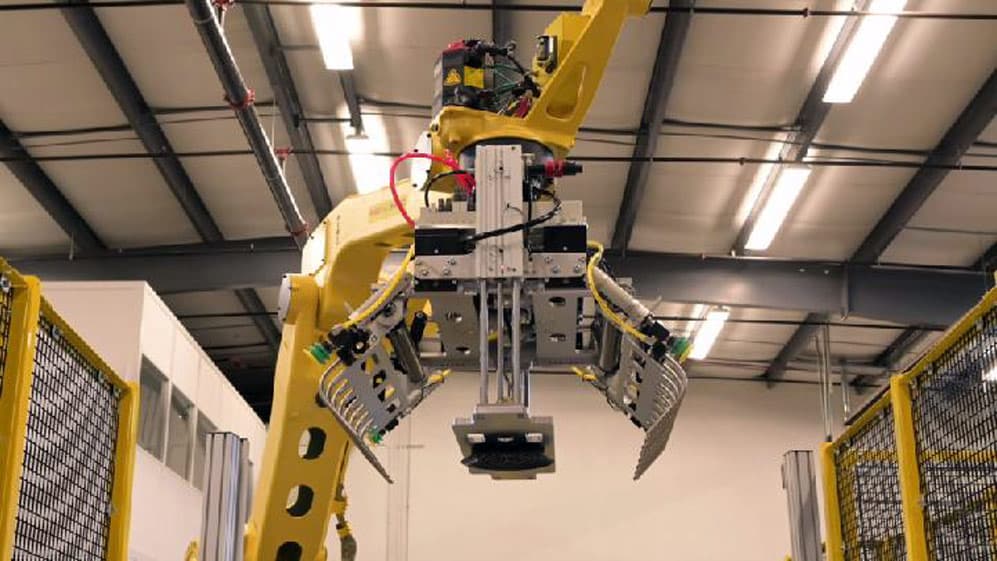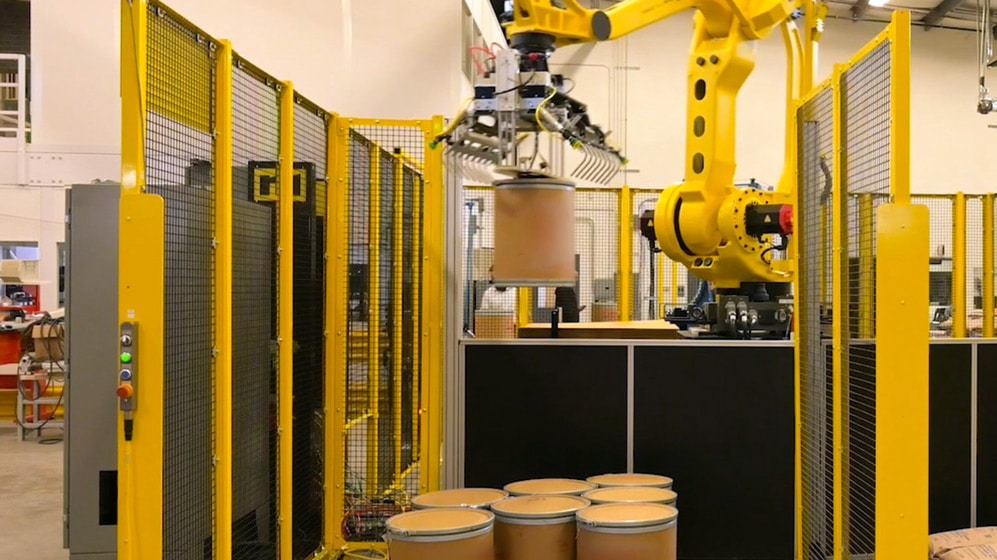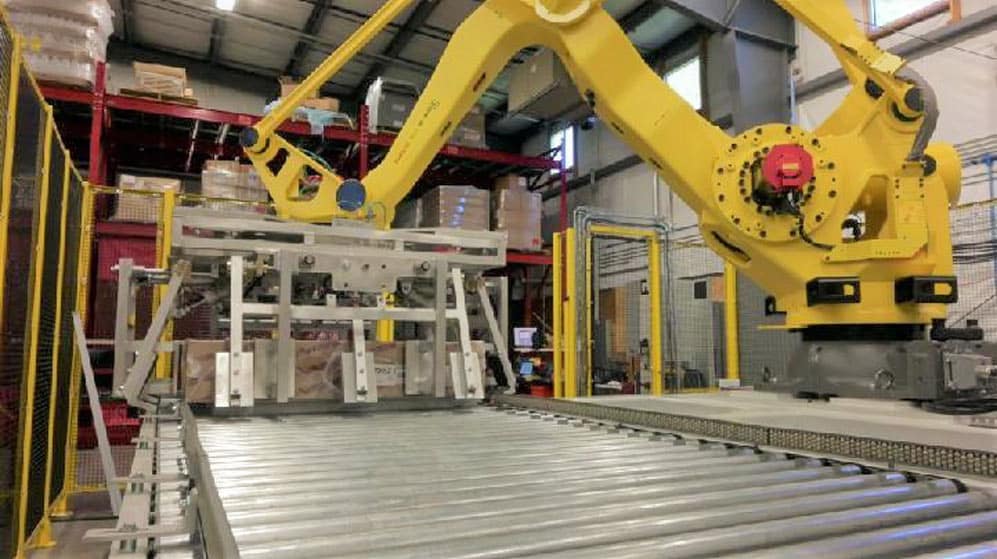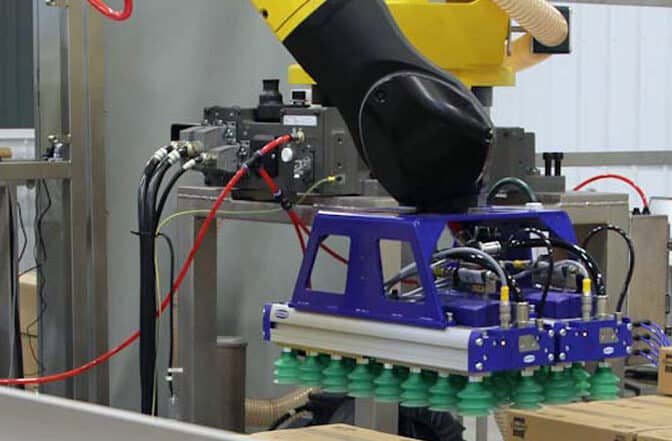End of arm tooling (EOAT) is an essential component in material handling automation. It’s important to have a comprehensive understanding of its key features and capabilities to ensure maximum efficiency for your production line. Let’s review what EOAT is, the different types that are available and the benefits of adding robotics to your operations.
What Is End of Arm Tooling?
End of arm tooling (EOAT) is the device at the end of an industrial robot. EOAT systems can be used to precisely grip, hold and manipulate components during automated manufacturing processes, allowing for increased precision and efficiency in production.
With the specialized design of the EOAT, industrial robots can complete the following tasks and more:
- Machine tending: improves machine capacity and uptime by loading and unloading from machine tool when the machine is complete.
- Laser cutting: able to pick from parts table.
- Sealant application: consistently and accurately dispenses sealant products.
- Assembly: assembles more quickly and precisely.
- Pick and place: accurately picks and places products into shipping cartons.
- Welding: delivers consistent, accurate and tireless welding work.
- Palletizing and depalletizing: reduces injury and increases efficiency.
No matter the task, automation rewards you with efficiency, speed and accuracy every time, plus less waste and damage to products. Learn more about the different types of end of arm tooling for robots.
Robotic Grippers

There are many different kinds of robotic grippers. A few of the go-to gripppers are: vacuum grippers, bag grippers, pneumatic and servo-side grippers. Each type of robot gripper has its own advantages and disadvantages that should be considered when choosing the right type of tooling for a given application.
End of arm tooling grippers can be used to:
- Move and manipulate objects, ranging from heavy to lightweight and fragile
- Pick up parts and components
- Perform automated assembly tasks
- Complete palletizing or depalletizing
Vacuum Grippers
Vacuum grippers are a popular end-of-arm tooling choice in manufacturing due to their high level of flexibility. As the name suggests, vacuum end of arm tooling uses vacuum cups or pads
to create a secure grip.
Vacuum EOAT grippers are are ideal for applications where objects must be moved quickly and accurately, such as in packaging lines or palletizing.
Bag Grippers
Bag grippers are made with heavy duty fingers that typically mesh with inbound rollers. This makes them popular in most bulk bagging applications. Bag grippers can commonly handle bags up to 80 pounds.
Pneumatic Grippers

Pneumatic grippers are the strongest type of robotic gripper and are used in applications that require a lot of force to securely hold parts.
They generate their strength from pneumatic cylinders that are pressurized and generate forces up to thousands of PSI.
Servo-Electric Grippers

Servo-side grippers are becoming more and more popular because they’re easy to control. servo motors control the gripper jaws, which are very flexible and can handle a variety of materials. With the servo control, you can easily adjust the speed, location and forces on the fly between products.
Servo-side grippers are well-suited for precision applications and allow the user to regulate the speed and grip force on demand. They’re often used in machine tending or pick and place applications for fragile items or shelf pack cases.
Robotic Welding Torches
Robotic welding torches rapidly weld multiple parts with accuracy. They can be used for both MIG (Metal Inert Gas) and TIG (Tungsten Inert Gas) welding processes, allowing users to achieve higher levels of accuracy and productivity than manual welding.
Robotic Tool Changers
A robotic tool changer quickly and efficiently switches between different tools or attachments. It usually has two main components: a mounting plate that attaches the tool to the robot, and an actuator that allows the tool to be removed from the robot and placed back into it without having to manually remove it. Having an EOAT quick change option is especially helpful if you have a line that runs multiple products.
Unlock Efficiency with Custom End of Arm Tooling Solutions

Over the years, technology has evolved significantly for industrial robotics and end of arm tooling, allowing for faster and more precise robotic operation.
Improvements in control systems have allowed for faster robot movements, enabling robots to handle complex tasks quickly and efficiently. Sensors and cameras have improved vision-based tasking capabilities and have enabled robotic arms to precisely pick up parts or tools, even if they are not in an ideal position.
In addition, advances in grippers and other EOAT systems have made it easier to switch between different attachments or tools without having to manually configure them.
Ready to design a custom end of arm tooling solution? Our team of authorized FANUC robot integrators are ready to assist you. For more than 80 years, RMH Systems has led the way in material handling automation and industrial automation systems trusted by local manufacturers and Fortune 50 companies.
We simplify the end of arm tooling design process by handling it fully in-house, from engineering and implementation to aftermarket service. Contact us today to request a free, no-pressure automation consultation!